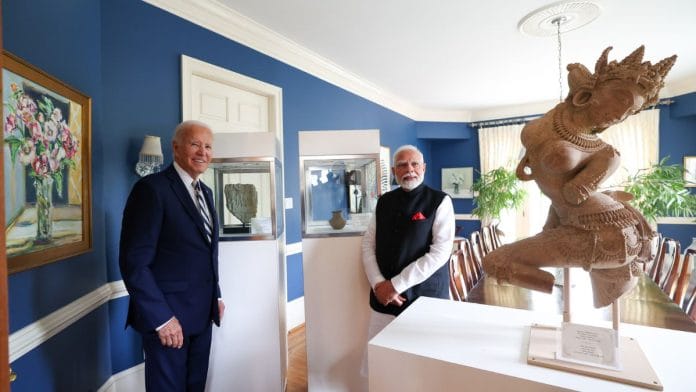New Delhi: As many as 297 antiquities from India will soon be on their way home from the United States after months of investigations and negotiations. During Prime Minister Narendra Modi’s three-day visit to the US, from 21 to 24 September, the US side facilitated the return of the antiquities, which had been “stolen” from or “trafficked” out of India, a statement issued Sunday by the Ministry of External Affairs (MEA) said.
“In a symbolic handing over, a select few pieces were showcased to the prime minister and President Biden on the sidelines of their bilateral meeting in Wilmington, Delaware,” the MEA statement read.
The process of getting back antiquities takes months and requires the detailed exchange of information.
“The embassy or consulate starts negotiations, on the advice of the Archaeological Survey of India, to share documents and photos pertaining to antiquity, to prove how the object belongs to our country. This is followed by discussions. Then, the antiquities are returned,” Dr Sanjib Kumar Singh, senior archaeologist and museologist at National Museum, New Delhi, told ThePrint.
These antiquities are a mix of ones returned by the Metropolitan Museum of Art or Met in New York, and some confiscated by US authorities that were lying in the New York attorney general’s office.
“Deepening cultural connect and strengthening the fight against illicit trafficking of cultural properties,” Modi wrote on X.
Deepening cultural connect and strengthening the fight against illicit trafficking of cultural properties.
I am extremely grateful to President Biden and the US Government for ensuring the return of 297 invaluable antiquities to India. @POTUS @JoeBiden pic.twitter.com/0jziIYZ1GO
— Narendra Modi (@narendramodi) September 22, 2024
Antiquities date back to 2000 BCE
The antiquities belong to a time period spanning almost 4,000 years—from 2000 BCE to 1900 CE—and have origins in different parts of India. Most of these are terracotta artefacts from eastern India, while others are made of stone, metal, wood and ivory, and are from to different parts of the country.
A key figure associated with these artefacts reaching the US is Subhash Kapoor. He ran an art gallery in the country, and 2,500 items trafficked by him and his network were recovered by the district attorney of New York and US Homeland Security investigations from 2011 to 2022.
The artefacts were estimated to be worth over $143 million. Of these, 307 antiquities, worth $4 million, were to be returned to India.
Some of the notable items in the list include an apsara in sandstone from central India (10th-11th centuries CE), a Jain Tirthankar in bronze from central India (15th-16th centuries CE), and the Hindu god Vishnu in bronze from eastern India (17th-18th centuries CE).
Many items were also found to be part of the inventory at the Met, which announced in 2023 that 15 items would be returned to India.
Of these, a 1st century BCE terracotta yakshi from West Bengal, a bronze sculpture of the god Revanta returning from a hunt (10th century CE), and a 15th-century parikara (backplate) were significant antiquities.
“Last month, in light of new provenance information, we returned 16 works to India, including the celestial dancer, a sculpture that enraptured visitors for decades,” museum director Max Hollein said in a statement.
These items have now been handed over formally as part of the 297 antiquities.
Also Read: MEA terms The Washington Post report on R&AW’s role in Pannun plot ‘speculative, irresponsible’
How antiquities are returned
The handing over and return of artefacts, such as the ones President Biden handed over, is done under India’s Antiquities and Art Treasures Act, 1972.
Antiquities require proper identification, registration and accession to help keep them safe. Accession refers to the number assigned to an artefact or data for permanent storage and curation in a collection facility.
The other challenge is the gap between the ‘official’ records of an artefact being lost, and when it surfaces in overseas markets or in the catalogues of museums such as the Met.
When stolen from smaller temples, the official route of establishing all the details and then tracing them to markets all over the world takes a lot of time.
“These smugglers often target objects which cannot be found outside of India, or are unique to the region, like yogini, or statues of various gods. These become extremely valuable, both in terms of their monetary worth and cultural significance,” Sanjib Kumar, spokesperson for the National Museum, New Delhi, told ThePrint.
Thanks to the efforts of the Indian government, some have at least been returned.
“The return of antiquities is of course part of diplomacy, but, either way, it is a great moment for India’s cultural heritage,” Kumar added.
(Edited by Radifah Kabir)
Also Read: China isn’t mocking India as usual. It’s praising Modi’s Russia-West balancing act instead






